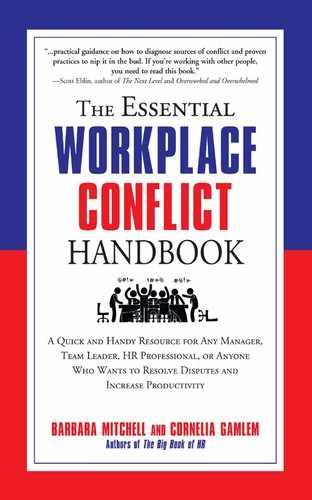INDEX
Accessibility of management, 187
Accommodating style, 142, 144, 147–148, 151, 216
Achievement, 207
Actions, 180
Active listening, 97–101
Alternative dispute resolution, 199, 204
American Arbitration Association, 200
Appreciative listening, 212
Approaches to leadership, 117–119
Armstrong, Sharon, 26
Ascription, 207
Assertiveness, 142
Assumptions, 46–49, 71–72, 87, 92, 180
Assumptions, listening and, 92
Attending skills, 75
Avoiding style, 143, 144–145, 148–149, 150–151, 217
Baby Boomers, 45
Balance, 83–84
Barriers to communication, 208
Behavior, constructive, 84
Behaviors, disruptive, 23, 167–184
Beliefs, listening and, 91
Big Book of HR, The, 142, 189, 198
Blame, 210
Boundaries, 176
Bullying policy, 194
Bullying, 170, 174–176, 193–194
Change, approach to, 42
Clarifying skills, 76
Closed-ended questions, 79, 99
Collaborating style, 143, 145, 149, 151, 218
Collaboration, 154
Commitment, 36
Communication breakdown, 63
Communication cycle, the, 211
Communication style, 42
Communication, barriers to, 208
Communitarianism, 206
Competing style, 142, 144, 146–147, 150, 216
Competition, 56
Comprehensive listening, 213
Compromising style, 143, 145–146, 149, 151, 217
Conclusions, jumping to, 22
Conduct policy, 191–192
Conflict style, 141–152
Conflict, owning a, 157–161
Confrontation, respectful, 181–183
Consequences, 121
Constructive behavior, 84
Conversations, effective, 74–78
Cooperativeness, 142
Core dimensions, 40
Covey, Stephen, 62
Creativity, 165
Criteria, objective, 134–138
Culture, 40–42
Culture, dimensions of, 205
Culture, listening and, 92
Curiosity, 80
Curiosity, respectful, 52–53
Descriptive questions, 80
Differences, 44–46
Dignity, 52
Dimensions of culture, 205
Discerning listening, 213
Discipline process, 192
Dispute resolution, alternative, 199, 204
Disrespect, 168–170
Disrespect, spiral of, 219
Disruptive behaviors, 167–184
Disruptive behaviors, 23
Diversity self-assessment planner, 209
Diversity, 20, 21, 39–54, 61–62, 69
Eblin, Scott, 195
E-communications, 93
Effective conversations, 74–78
Eisaguirre, Lynne, 20, 90, 104, 146
Emotional Intelligence, 68
Emotions, listening and, 92
Emotive questions, 80
Empathic listening, 212
Employee Assistance Programs (EAPs), 196–197, 200
Employee training, 197
Employment discrimination laws, 198–199, 220–221
Encouraging skills, 76
Essential Manager’s Handbook, The, 68
Essential Performance Review Handbook, The, 26
Evaluative listening, 213–214
Expectations, 22, 84, 107–121, 188, 191
Expectations, unclear, 188
Factual questions, 79
Fair Labor Standards Act, 198
Family and Medical Leave Act, 198
Federal Mediation and Conciliation Service, 200
Feeling questions, 80
Feelings, 82–84
Fisher, Roger, 124
Flexibility, workplace, 198–199, 204
Flex-time, 198
Future Shock, 26
Generations in the workplace, 26, 44–45
Getting to Yes, 124
Giving good information, 81–82
Global economy, 26
Globalization, 21
Goals, 58
Goleman, Daniel, 68
Goulston, Mark, 103
Hampden-Turner, Charles, 41–42, 205
Harassment policy, 192–193
Harassment, 154, 168–169, 170, 172–173, 178–179
Hersey/Blanchard Situational Leadership Model, 118, 119, 214
Impact, intent cs., 178–180, 183
Individualism, 206
Information, giving good, 81–82
Information, obtaining, 78–81
Innovation, 165
Intent, impact vs., 178–180
Interest, position vs., 22, 124–125
Interests, shared, 135
Internet generation, 45
Interrupting, 84
Job freedom, 34
Job security, 33
Judgment, 87
Jumping to conclusions, 22
Kabat-Zinn, Jon, 195–196
Korolyi, Bela, 118
Laws, employment discrimination 198–199, 220–221
Leadership, approaches to, 117–119
Leadership, new, 28–29
Listening styles, 212–214
Listening, active, 97–101
Listening, reflective, 101–103
Management accessibility, 187
Management techniques, 186–188
Management training, 188–189
Mediation, 155–157, 218–219, 199
Meetings, 60
Mentoring, 189
Micro-inequities, 169, 170–172
Mindfulness, 195–196
Motivation, 112–114
New hires, 30
New leadership, 28–29
Nycz-Connor, Jennifer, 92
Objective criteria, 134–138
Obtaining information, 78–81
Occupational Safety and Health Act, 199
Office redesign, 31–32
Office relocation, 31–32
Open-door policy, 187
Open-ended questions, 78–79, 99
Opinion-based questions, 80
Options, 129–133
Overworked and Overwhelmed, 195
Owning a conflict, 157–161
Parcells, Bill, 117
Participation, 61
Particularism, 206
Patience, 101
Peer review panels, 199–200
Perceptions, listening and, 92
Personal initiatives, 53–54
Perspectives, 48
Policies, new, 32–33
Position, interest vs., 22, 124–125
Power of a Good Fight, The, 20, 90, 104, 146, 216
Preferred conflict style, 146, 150–151, 152
Pride in the organization, 34–35
Primary dimensions, 40
Probes, 99
Problem-solving style, 42
Programs, wellness, 194–196
Questions, closed-ended, 79, 99
Questions, descriptive, 80
Questions, factual, 79
Questions, feeling, 80
Questions, open-ended, 78–79, 99
Questions, opinion-based, 80
Questions, reflective, 79
Raised expectations, 116–117
Reflecting skills, 76–77
Reflective listening, 101–103
Reflective questions, 79
Relationships, listening and, 92
Reporting relationships, 29–30
Resignation, 34
Resisting change, 27
Respect, 52
Respectful confrontation, 181–183
Respectful curiosity, 52–53
Responsibilities, new, 33–34
Riding the Waves of Culture, 41, 205
Rowe, Mary, 170
Secondary dimensions, 40
Secrecy, 66
Sequential time, 207
Setting the tone, 108
Setting, listening and, 91
Seven Habits of Highly Effective People, The, 62
Sexual harassment, 178
Shared interests, 135
Shared standards, 135
Socialization, 46–49
Solutions, finding creative, 130
Spiral of disrespect, 219
Status, 207
Stereotypes, 46–49
Style, communication, 42
Style, conflict, 141–152
Synchronous time, 207
Systems, new, 30–31
Team conflicts, 65–66
Team conflicts, examples of, 209–210
Team members, new, 30
Team norms, 59–61
Teamwork, 55–69
Techniques, management, 186–188
Technology, new, 30–31
Time, managing, 207
Timing, listening and, 91
Toffler, Alan, 26
Tone, setting the, 108
Traditionalists, 45
Training, employee, 197
Training, management, 188–189
Universalism, 206
Ury, William, 124
Violence, bulling and, 175
Walsh, Bill, 118
Wellness programs, 194–196
Workplace change, 25–37
Workplace violence, 170
